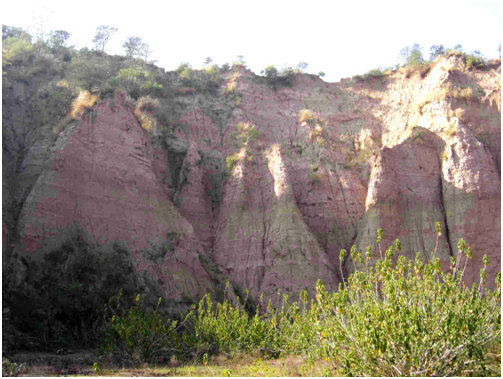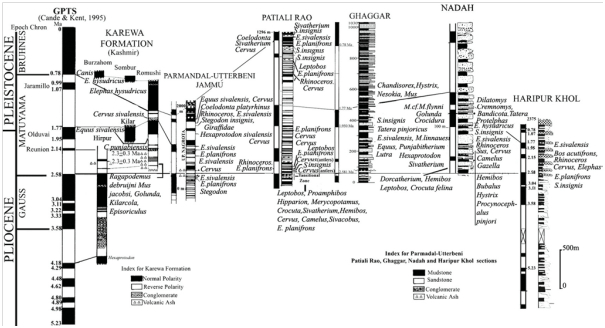Pinjor Fm
Type Locality and Naming
Named after the township of Pinjore situated ~15 km North of Chandigarh. Type section is in Patiali Rao Section. Its thickness in type section is ~1200 m. [Original Publication: Pilgrim, G.E. (1910): Preliminary note on a revised classification of the Tertiary freshwater deposits of India. Records of Geological Survey of India, 40(3): 185-205; Pilgrim, G.E. (1913). orrelation of the Siwaliks with Mammal Horizons of Europe. Records of Geological Survey of India, 43 (4): 264-326 pt.4, pls. XXVI-XXVIII.]. Reference section: Marikhui Member, Uttarbaini Fm, Jammu (Gupta and Verma, 1988); Gupta and Verma (1988) have reported 18 mammalian taxa (Nanda, 2015). Its thickness in reference section is 1524 m.
Synonyms: Uttarbaini Fm, Jammu (Gupta and Verma, 1988); Nagrota Fm, Jammu (Ranga Rao et al., 1988), Patiali Rao Section (Nanda, 2015), India. Samwal Fm in Potwar Plateau of Pakistan (Flynn et al., 2013). Samwal Fm ranges in age from ~3.6 to 1.5 Ma and hence in part equivalent to combined Tatrot Fm and Pinjor Fm (Arif, 1985, Hussain et al., 1992; Barry et al., 2013).
[Figure 1: Structural Map of Masol Area after Sahni and Khan (1968) (adopted from Chapon et al., 2016)]
Lithology and Thickness
Sandstone. Brown to greyish-brown, fine-, medium- and coarse-grained sandstone, multi-storey sandstone, pebbly sandstone, pedogenic and non-pedogenic overbank deposits (Kumar and Tandon, 1985). Its thickness is approx. 575 m.
Lithofacies: Pebbly sandstone facies (St), Medium to coarse-grained sandstone facies (St-Sp facies); Bioturbated calcareous fine-grained sandstone facies (FI facies); Parallel-laminated bioturbated mudstone facies (Fsc facies); Brown pebbly mudstone facies (Fm facies); Bluish grey to violet mudstone facies (Fcf facies).
[Figure 2: Pinjor Formation outcrop near Masol, ~12 km north of Chandigarh]
Relationships and Distribution
Lower contact
In the proposed type section the contact of Pinjor with the underlying Tatrot Fm is gradational.
Upper contact
Upper contact shows gradual increase in pebbly beds; gradual decrease of sandstone and mudstone. In the proposed type section the contact of Pinjor with the overlying Boulder Conglomerate Fm is gradational. In the reference section too, the contact is gradational with the overlying Dughor Fm and gradational with the underlying Labli Member of Uttarbaini Fm (Gupta and Verma, 1988).
Regional extent
GeoJSON
Fossils
[Table 1. Pinjor Formation mammalian taxa from Chandigarh region (data from Nanda, 2002, 2013, 2015; Raghavan et al., 2007; Patnaik, 2013)]
LIPOTYPHLA (=INSECTIVORA): Chandisorex punchkulaensis
PRIMATES: Procynocephalus pinjorii, Theropithecus delsoni
RODENTIA: Nesokia punchkulaensis, Rattus sp., Hystrix leucurus, Mus linnaeusi, M. cf. M. flynni, Cremnomys cf. C. blanfordi, Golunda sp., Dilatomys sp., Hadromys loujacobsi, Hadromys sp., Tatera pinjoricus, Anepsirhizomys pinjoricus (=“Rhizomys” pinjoricus us), Bandicota sp.
LAGOMORPHA: Caprolagus sivalensis
CARNIVORA: Canis pinjorensis, Mellivora sivalensis, Enhydriodon sivalensis, Lutra sp., L. palaeindica, Amblonyx indicus, Amblonyx sp., Pachycrocuta brevirostris (=Crocuta felina, =C. sivalensis, =C. colvini), Panthera cf. P. cristata, Hyaenictis bosei, Megantereon palaeindicus, Sivapanthera (=Sivafelis) potens
PROBOSCIDEA: Stegodon pinjorensis, Stegodon sp., Elephas hysudricus, E. platycephalus
PERISSODACTYLA: Equus sivalensis, Punjabitherium platyrhinus, Rhinoceros palaeindicus, R. sivalensis, Rhinoceros sp.
ARTIODACTYLA: Potamochoerus theobaldi, Sus falconeri, S. hysudricus, S. giganteus, S. choprai, Propotamochoerus sp., Cervus sivalensis, C. punjabiensis, C. simiplicidens, Cervus sp., Sivachoerus sp., Sivatherium giganteum, Sivacapra subhimalayaensis, Damalops palaeindicus, Oryx (= Sivoryx) sivalensis, Sivacobus palaeindicus, Antilope subtorta, Vishnucobus (=Indoredunca) sterilis, Hemibos acuticornis, H. triquetricornis, H. antilopinus, Bubalus bubalis var. palaeindicus, B. platyceros, Leptobos falconeri, Bison sivalensis, Bos acutifrons
Extend from the Tatrot Fm to Pinjor Formation
Crocidura sp., Golunda kelleri, Prototocyon (=Sivacyon) curviplatus, Anancus (=Pentalophodon) sivalensis, Stegolophodon stegodontoides, Stegodon insignis, S. katliensis, Elephas planifrons, ?Chilotherium intermedium, Potamochoerus palaeindicus, Hippohyus sivalensis, Hexaprotodon sivalensis, Camelus sivalensis, ?Dorcatherium sp., Cervus cf. C. triplidens, Gazella cf. G. lydekkeri, ?Gazella sp.
Age
Depositional setting
High-gradient, low-sinuosity streams, mainly of piedmont drainage system (Kumar and Tandon, 1985). Alternate sequence of conglomerate with sandstone, siltstone and mudstone indicates a gradual transition of channels to a braided pattern. A huge thickness of pebbly sandstone and conglomerate as well as lithological variation from sandy clay facies to arenaceous facies constitutes Pinjor Formation that indicate drastic changes in the stream regimes; proximal to distal facies variations within the vertical accretion flood plain deposits as a result of the increased sinuosity and decreased basin subsidence. Large-scale current bedding and truncated horizontal channel fills indicate a fluvial origin and the channel fills may be the result of the decrease in stream velocity or increase in the stream load producing parallel layering (Kumar et al., 2012).
Additional Information
[Figure 3: Magnetostratigraphy of the Patiali Rao section from Ranga Rao (1993) and Ranga Rao et al. (1995) (adopted from Chapon et al., 2016)]
[Figure 4: Various mammal-bearing Plio-Pleistocene sections in India which are well-dated using either magnetostratigraphy or tephrachronology or both. Data compiled from Azzaroli and Napoleone (1982), Tandon et al. (1984), Ranga Rao et al. (1988, 1995), Kotlia (1990), Agarwal et al. (1993), Sangode et al. (1996); Kumaravel et al. (2005); Patnaik and Nanda (2010)]



